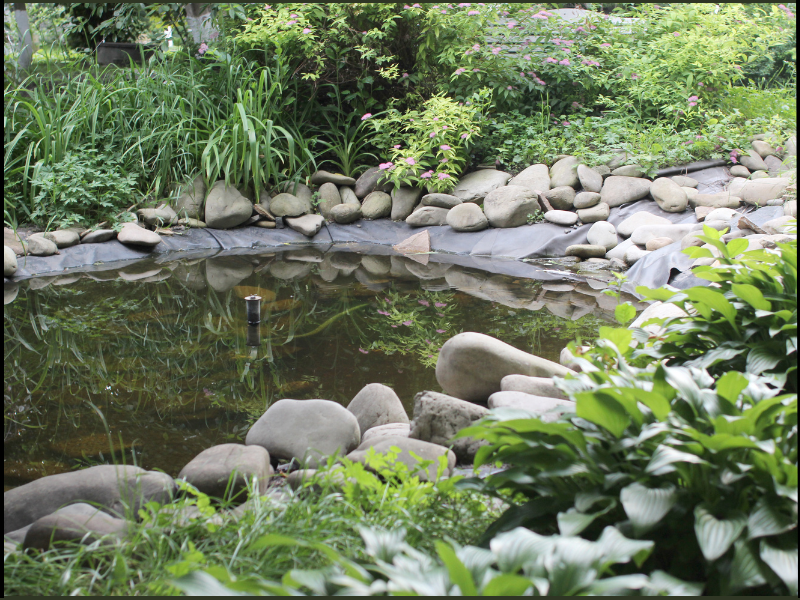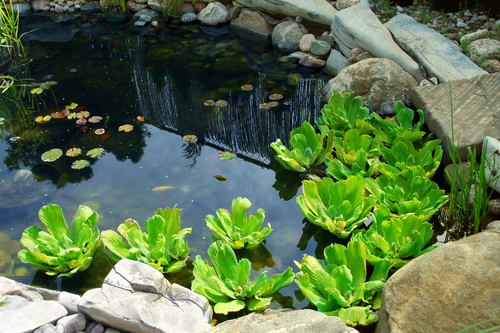Designing your pond can seem a little daunting particularly if you have no prior experience. Let’s start with some key details to help you to design the perfect pond for you. We hope you find the following steps useful.
1. Purpose for building a pond
What is the main goal for your pond?
- Decorative (for aesthetic appeal)
- Fish pond (koi, goldfish, or other species)
- Wildlife habitat (to attract birds, frogs, etc.)
- Swimming pond
- Irrigation or farm pond
2. Size and shape
- How much space do you have available?
- Do you want a natural, freeform shape or a more structured, geometric design?
- Approximate depth preference? (Shallow ponds are good for plants, deeper ponds help keep fish safe)
3. Location
- Is your area mostly sunny, partially shaded, or fully shaded?
- Do you want it near your home, patio, or further in the yard?
- Are there trees nearby? (Leaves can be an issue)
4. Filtration and water features
- Do you want a waterfall, fountain, or stream?
- Will you use a pump and filter, or do you prefer a natural eco-pond?
- Do you want underwater lights for night-time beauty?
5. Plants and wildlife
- Would you like aquatic plants (lilies, reeds, oxygenating plants)?
- Do you want to attract birds, frogs, or beneficial insects?
- Are you concerned about predators like herons or raccoons?
6. Budget and materials
- Do you prefer a rubber pond liner, pre-formed shell, or a natural clay pond?
- Are you planning a DIY build, or hiring professionals?
- Do you have a rough budget in mind?

Here is an example of how to plan and budget your pond build:
Example, you want a decorative pond, free form shape, about 5m x 4m, location in a sunny area, include a fountain and aquatic plants. Budget is about £1000. Here’s a basic plan tailored to your needs:
Pond design and layout
- Shape: Freeform, natural-looking curves to blend with the landscape.
- Size: 5m x 4m, with a depth of around 60-80cm (deeper in the center, shallower at the edges for plants).
- Location: Full sun, which is great for flowering aquatic plants, but may require algae control.
Materials & Estimated Costs
| Item | Estimated Cost (£) |
|---|---|
| Epalyn rubber liner (6m x 5m) | 270-350 (£277.50 from Liners Online) |
| Protective underlay (fleece or sand base) | 70-80 (£75.00 from Liners Online) |
| Pond pump & fountain | 150-250 |
| Aquatic plants (water lilies, oxygenators, marginals) | 100-200 |
| Rocks & gravel (for edging and decoration) | 150-200 |
| Tubing & fittings | 50-100 |
| Extras (lighting, fish, netting, sealant, etc.) | 100-150 |
| Total Estimated Budget | £850-1000 |
Features and additions
Fountain: A solar-powered or electric fountain for aeration and aesthetics.
Aquatic plants: Water lilies (for shade), oxygenating plants (to keep water clear), and marginals (for edges).
Edging: Natural rocks, pebbles, or plants to blend with the garden.
Wildlife-friendly: Shallow edges for birds and beneficial insects.
Here’s a step-by-step guide to sketch your pond design:
Materials Needed:
- Graph or plain paper
- Pencil and eraser
- Ruler (optional, for rough dimensions)
- Colored pencils or markers (optional, for depth and detail)
Step-by-Step Instructions:
- Outline the Pond Area:
- Begin by drawing a rough rectangle or a light grid to represent the overall space available.
- Within that space, sketch a freeform, irregular shape that approximates a 5m x 4m pond. Don’t worry about perfect symmetry—the natural curves add character.
- Define the pond’s depth:
- Indicate that the pond is deeper in the center and shallower at the edges.
- You can do this by lightly shading the center area darker and the edges lighter, or by drawing contour lines (like topographic lines) that suggest a gradual depth change.
- Mark the fountain location:
- Draw a small circle or fountain symbol roughly in the center of the pond (or slightly off-center if you prefer a more natural look).
- From this circle, you can add radiating lines or gentle curves to symbolize water being pushed outwards.
- Plan the aquatic plants:
- Floating Plants: Add small, round shapes to represent water lilies. Place a few around the fountain area to catch the eye.
- Marginal Plants: Draw elongated, leaf-like shapes along the pond’s edges to represent plants growing in the shallow areas. Vary their sizes to create a natural look.
- Add edging and decorative elements:
- Around the outer boundary of the pond, sketch irregular lines or clusters of small shapes to represent natural rocks or pebbles.
- Consider drawing a few stepping stones if you envision easy access to the pond’s edge.
- Label key features:
- Clearly label the fountain, aquatic plants (e.g., “water lilies,” “marginal plants”), and any special areas like deeper zones or rock borders.
- This can help keep the design organized if you plan to reference it during construction.
- Review and refine:
- Step back and look at your sketch. Make sure the proportions feel right for a decorative pond in a sunny area.
- Erase any stray lines and add any final details that highlight the natural, freeform appearance.
Optional Enhancements:
- Colour coding: Use blue shades for water, greens for plants, and browns/greys for rocks to add visual interest.
- Water flow: You can add small arrows or curves around the fountain to show how the water will circulate, which can help plan for aeration and plant placement.
This sketch will serve as a conceptual guide for building your pond within your £1000 budget, ensuring you cover all essential design elements. Enjoy the process of bringing your pond design to life!
















